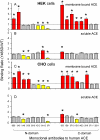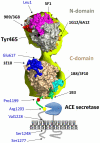An angiotensin I-converting enzyme mutation (Y465D) causes a dramatic increase in blood ACE via accelerated ACE shedding
- PMID: 21998728
- PMCID: PMC3187827
- DOI: 10.1371/journal.pone.0025952
An angiotensin I-converting enzyme mutation (Y465D) causes a dramatic increase in blood ACE via accelerated ACE shedding
Abstract
Background: Angiotensin I-converting enzyme (ACE) metabolizes a range of peptidic substrates and plays a key role in blood pressure regulation and vascular remodeling. Thus, elevated ACE levels may be associated with an increased risk for different cardiovascular or respiratory diseases. Previously, a striking familial elevation in blood ACE was explained by mutations in the ACE juxtamembrane region that enhanced the cleavage-secretion process. Recently, we found a family whose affected members had a 6-fold increase in blood ACE and a Tyr465Asp (Y465D) substitution, distal to the stalk region, in the N domain of ACE.
Methodology/principal findings: HEK and CHO cells expressing mutant (Tyr465Asp) ACE demonstrate a 3- and 8-fold increase, respectively, in the rate of ACE shedding compared to wild-type ACE. Conformational fingerprinting of mutant ACE demonstrated dramatic changes in ACE conformation in several different epitopes of ACE. Cell ELISA carried out on CHO-ACE cells also demonstrated significant changes in local ACE conformation, particularly proximal to the stalk region. However, the cleavage site of the mutant ACE--between Arg1203 and Ser1204--was the same as that of WT ACE. The Y465D substitution is localized in the interface of the N-domain dimer (from the crystal structure) and abolishes a hydrogen bond between Tyr465 in one monomer and Asp462 in another.
Conclusions/significance: The Y465D substitution results in dramatic increase in the rate of ACE shedding and is associated with significant local conformational changes in ACE. These changes could result in increased ACE dimerization and accessibility of the stalk region or the entire sACE, thus increasing the rate of cleavage by the putative ACE secretase (sheddase).
Conflict of interest statement
Figures










Similar articles
-
Angiotensin I-converting enzyme mutation (Trp1197Stop) causes a dramatic increase in blood ACE.PLoS One. 2009 Dec 14;4(12):e8282. doi: 10.1371/journal.pone.0008282. PLoS One. 2009. PMID: 20011602 Free PMC article.
-
Proteolytic release of membrane-bound angiotensin-converting enzyme: role of the juxtamembrane stalk sequence.Biochemistry. 1996 Jul 23;35(29):9549-59. doi: 10.1021/bi9602425. Biochemistry. 1996. PMID: 8755736
-
Angiotensin I-converting enzyme Gln1069Arg mutation impairs trafficking to the cell surface resulting in selective denaturation of the C-domain.PLoS One. 2010 May 3;5(5):e10438. doi: 10.1371/journal.pone.0010438. PLoS One. 2010. PMID: 20454656 Free PMC article.
-
Secretase-mediated cell surface shedding of the angiotensin-converting enzyme.Protein Pept Lett. 2004 Oct;11(5):423-32. doi: 10.2174/0929866043406544. Protein Pept Lett. 2004. PMID: 15544563 Review.
-
[Angiotensin converting enzyme (kininase II). Molecular and physiological aspects].C R Seances Soc Biol Fil. 1992;186(6):586-98. C R Seances Soc Biol Fil. 1992. PMID: 1339589 Review. French.
Cited by
-
Lysozyme and bilirubin bind to ACE and regulate its conformation and shedding.Sci Rep. 2016 Oct 13;6:34913. doi: 10.1038/srep34913. Sci Rep. 2016. PMID: 27734897 Free PMC article.
-
Advances in the structural basis for angiotensin-1 converting enzyme (ACE) inhibitors.Biosci Rep. 2024 Aug 28;44(8):BSR20240130. doi: 10.1042/BSR20240130. Biosci Rep. 2024. PMID: 39046229 Free PMC article. Review.
-
A novel splice-site mutation in angiotensin I-converting enzyme (ACE) gene, c.3691+1G>A (IVS25+1G>A), causes a dramatic increase in circulating ACE through deletion of the transmembrane anchor.PLoS One. 2013;8(4):e59537. doi: 10.1371/journal.pone.0059537. Epub 2013 Apr 1. PLoS One. 2013. PMID: 23560051 Free PMC article.
-
A novel angiotensin I-converting enzyme mutation (S333W) impairs N-domain enzymatic cleavage of the anti-fibrotic peptide, AcSDKP.PLoS One. 2014 Feb 4;9(2):e88001. doi: 10.1371/journal.pone.0088001. eCollection 2014. PLoS One. 2014. PMID: 24505347 Free PMC article.
-
Blood ACE Phenotyping for Personalized Medicine: Revelation of Patients with Conformationally Altered ACE.Biomedicines. 2023 Feb 13;11(2):534. doi: 10.3390/biomedicines11020534. Biomedicines. 2023. PMID: 36831070 Free PMC article.
References
-
- Ehlers MWR, Riordan JF. Angiotensin-converting enzyme: new concepts concerning its biological role. Biochemistry. 1989;8:5311–5318. - PubMed
-
- Skidgel RA, Erdos EG. Biochemistry of angiotensin I- converting enzyme. In: Robertson JIS, Nichols MG, editors. The Renin-Angiotensin System. Glower Medical Publishing, New York; 1993. pp. 10.1–10.10.
-
- Corvol P, Eyries M, Soubrier F. Peptidyl-dipeptidase A/Angiotensin I-converting enzyme. In: Barret A, Rawlings N, Woessner J, editors. Handbook of Proteolytic Enzymes. Elsevier Academic Press. New York; 2004. pp. 332–349.
-
- Bernstein KE, Xiao HD, Frenzel K, Li P, Shen XZ, et al. Six truisms concerning ACE and the renin-angiotensin system educed from the genetic analysis of mice. Circ Res. 2005;96:1135–1144. - PubMed
-
- Caldwell PR, Seegal BC, Hsu KC, Das H, Soffer RL. Angiotensin-converting enztme: vascular endothelial localization. Science. 1976;191:1050–1051. - PubMed
Publication types
MeSH terms
Substances
Grants and funding
LinkOut - more resources
Full Text Sources
Molecular Biology Databases
Miscellaneous

